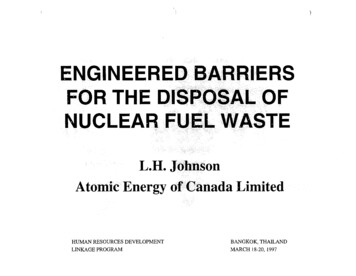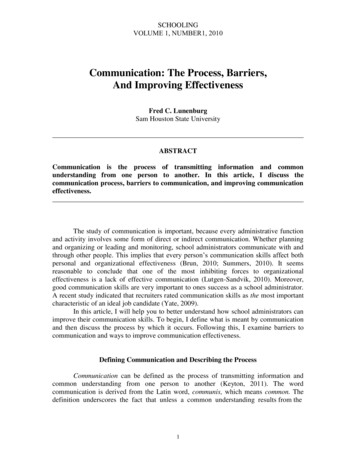
Transcription
)ENGINEERED BARRIERSFOR THE DI5,ROIAl OFNUCLEAR FUEL WASTE."",' .: . ' . " . . ,."" . .L.H. JahfisonAtomic Energy of Canada LimitedHUMAN RESOURCES DEVELOPMENTLINKAGE PROGRAMBANGKOK, THAILANDMARCH 18-20, 1997
REGULATORY REQUIREMENTSFOR HIGH-LEVEL WASTEDIS·POSALIAEA- Safety Principles aluITech. icalCriteria for t eUndergrollndDisposalof High-LeveL:R ioactiveWastes:IAEA SafetyS .i sNo. 99 (IAEA 1989)CANADA-R. glllatory DO J.J.ll1ents:R-72 (AECB 1987),R-I04 (AECB 1987)
KEY IAEA TECHNICAL CRITERIAFOR ENGINEERED BARRIERS(IAEA. t9/89) The long-term safety of high-Ievelra ioactivewastedisposal shall be based on the multibarrier concept andshall be addressed on the1J sisofthe disposal system as awhole. Substantially complete isolationfor an initial period of time Repository ()p ration and closure should preserve thepost-sealing/§afety functions ofthe host rock Waste should be emplaced such that fissile materialremains in a subcritical configuration
REGULATORY REQUIREMENTSRELEVANT TO ENGINEERED BARRIERSFOR GEOLOGIC D1SpjQSALOF NUCLEAR.,.;. ::.:. . .;. .:." :;:.:.:.','.FUELiwlsTr:1. No dependence on intervention in the post-closure periodshould be required2. A quality .assurance pr()g fl.mm.llst be in place at all stages:: :i': ::', nJ:d'\. ,"\Y.'3. Multiple (engineered plus Il.31tlltal) barriers lllustbe used4. The disposal system must not be compromised byprovisions fora.pre-closure measurementsb. post-closure retrievalc.post-closure measurements
REQUIREMENTS FOR DETERMININGTHE ACCEPTABILITY OFA DISPOSALCONCE PTCRITERIA1.that define t ; ;; "!! ; : 2. METHODOLOGY toev@lt1.at t eperforma ceof aproposed disposal sysfelllaga.!]j}sttlle safety··criteria3.TECHNOLOGY to site, desjgp.,build, operate,decomnlission and close a disposal facility tllat satisfiestile safety criteria4.CONFIDENCE tllat an acceptable site exists, tllat,together with a suitably designed facility, would meetthe safety criteria
ENGINEERED BARRIERS - GUIDINGPRINCIPLES FOR R&D PROGRAM- compatible with disposalat,i§.fJQ.-lfJQQ-mdepth inplutonic rock/ i- design technically f asi lefitlt availabletechnology, or reasonabl h.ievabledevelopments- flexible design approach Qprovide a range ofoptions- engineered barriers perfOrmance assessed interms of th.e overall disposal system
ENGINEERED BARRIERS R&DOBJECTIVES-evaluate the performance ora used fuel as a waste form-develop and assess processes a l . fo s forimmobilizing wastes from fuelre"'pro(Jes·sing. :.: :.: . : .-".:,: . :.'"-develop containers to isolate tIle waste for an appropriateperiod-develop materials and desigI.l.§ ineffectively seal adisposal vault-develop models to describe the rate of release andtransport of radionuclides tnthe geosphere-develop the base of understanding to defend the modelsand to define the limits of acceptable performance of theengineered barriers
WASTE FOFlMS OP'fIONS CFlARAC'fERIZAr.EION RADIONUCLIDE IN EN'fORIES RELEASE CFlARAC'fERIS'fICS CONCEP'fUAL MODELS FOR RELEASE MA'fFlEMA'fICALMODELS FORRELEASE
Fl Fl'r.I, ·OiO· ·O-lS·O ·oioio- ·o. . . - - .- .-. . -I449 emTOP VIEW- . - . . .O O O O . - . - . O D O O --.FUEL ROD.II381 emACTIVEiISPACERIGRIDilBOTTOM VIEWTLWR FUEL ASSEMBLY
Products for Immobilization of High-level UquidFission Product and Actinide Reprocessing WastesVitrification (Immobilization in glass or glass-ceramic)-\Borosilicate Glass -International productreprocessing facilities.choicea'AECL-developed productsBorosilicate GlassesAluminosilicate GlassesSphene-based Glass-ceramicsProducts were developed to provide enhanced durability oveconventional borosilicate glasses and to be compatible with disposal ifa granitic rock rePository.Models were developed to describe the dissolution behaviour of theStProducts.Glass-melter technology was developed for the fabrication of theStwaste-fonns.Any Mure work would involve product optimization and scaling-upproduction technologies.0
Estimated Volumes of Waste Arising from Used Fuel Disposaland Fuel Reprocessing
Minimum Estimated Volumes of Waste Arising from Used Fuel Disposaland Fuel Reprocessing
Impact of Reprocessing on Waste DisposalDisposal of 63,400 fuel bundles (1200 Mg U) per year10 yealS cooledUsed FuelHigh-LevelReprocessing Waste880206622 m3107 m 311 kg47 kg9700 kg9700 kgHeat per Container286W1223 WTotal Heat252 kW252 kW# ContainelSContainer VolumeFission ProductWaste per ContainerTotal FissionProduct WastepTo maintain a maximum temperature of 90 C at the container surfaCEreprocessing waste containelS would require wider spacing.Volume of vault required for disposal of waste cooled for equivalent timperiod would be identical.
ADVANCED FUEL CYCLES.Slightly Enriched Uranium Oxide (0.9 - 1.5% U-235) Mixed-Oxide - (U, PU)02.Tandem - LWR -- CANDU.Thorium FuelDetailed Analysis of Environmental Impactsand Economic Aspec1s Not Yet Perfonned
CANDVPWRFuelNat. V0 20.7% 235UEnriched V0 2-3-4% 235VCladdingZircaIoyZircaloyAssembly length (m)0.5m·-4mRods/assembly28 or 3717 x 17V0 2 wt. (kg)21 kg523 kgBurnup (MWdlMTHM) 6000 - 12000Linear Power (kW/m) 20 - 55T centerline (OC)800 - 17008000 - 4000015 - 25800 -1200
AECLAECL ResearchEACLEACL RechercheFACTORS AFFECTING CHARACTERISTICS OFUSED FUEL FOR DISPOSAL Fuel history - burn up, linear power Fuel defects External contamination, crud Storage time, changes during storage Changes during transportationOc1oborll993
EFFECTS OF IRRADIATION ON V0 2 FUELoDuring irradiation of fuel in reactor, Actinides and many FissionProducts remain homogeneously distributed in V0 2 crystallinelattice.o. Some Fission Products may segregate to specific locations in theV0 2 fuel:Tc, Rh, Pd, Ru and Mo are insoluble in lattice and aresubmicroscopically dispersed iii. V0 2 lattice aud migrate toV0 2 grain .boundaries.Volatile Fission Products (e;g. Cs, I) and fission gases (Xe,Kr) migrate to V0 2 grain boundaries and also along grainb\}undaries to the fuel/Zircwoy sheath gap region.oHigh power/high temperature fuels will show the greatestsegregation and the highest concentrations of Cs, Xe and I in thegap region.For typical CANDV fuels, total fission product inventory may be:-0.05 to 15% (average -2%) in the gap region,-5% in grain boundaries,remainder (80-95%) in V0 2 matrix.
Release of Radionuclides from used FuelReleased instantly onexposure to groundwaterc:ZircaloysheathSolid fissionproductsc. Au. Mo. Pdl esin solidsolutionCU. An. LnIOzReleased instantly onexposure to groundwaterReleased slowly at arate controlled by thedissolution rate ofthe fuel matrixMI'96-028.32
RESEARCH TO EVALUATE DURABILITYOF USED FUEL DURING DISPOSAL INVENTORIES AND DISTRIBUTION OFRADIONUCLIDES IN USED FUELpredictive codes, e.g., ORIGEN-Smeasurements to validate predictions STUDIES OF DISSOLUTION OF USED FUELradionuclide release from fuel/cladding gapradionuclide release from grain boundariesradionuclide release from fuel matrixfuel/groundwater, multicomponent tests STUDIES OF DISSOLUTION OF U0 2in solutions containing O 2 and H 2 0 2effects of a and y radiolysisoxidative dissolution model development USED FUEL DISSOLUTION MODELevaluate instant releaseuranium solubility functionradionuclide solubilities STUDIES OF NATURAL ANALOGUESU-ore deposits
("oNt. P1'\)A'"Ot :'OL.U1'I 1\oIMobE.L I bA1' GAPP.EL.fA S.,(TRAIt.! BOUNt)AR.YI HVe.H 1"oRI e. 1'H fRNoDYNA"'IC- Mot .EL(UC\-LJ.o,SfN&IU1Y FIe.LO)RADloNvc.Llb oL.\)alL.I1"I StVAUt. Tt-\01)ELINSl'ANTfW-EA.se.MODeL.(CrAP AND 6.8)c. r c f".MA'fRlX OI OLu-rlo",RAfi,r:! MoDeL[ul )'fRAN po rRAt'S-
Unirradiated FuelUsed Fuel l--ActiveFission Products0.16% rr-Plutonium0.40% J--Other UIsotopes0.08%InactiveFission Products - - '0.66%\NewNuclides1.3% I-;II,,OtherActinides0.01%'- ---.i
10 6-.------------------------------,190 MWh/kg UTotal.'.'.'ActinidesFission Products102 ::Jtil :-(JlIII I II IIIIIII IIIIIII IIIIIIIIIIIII IIII,U in Secular Equilibrium10 1with Daughter ProductsGlen0,C10 '. ,,""'.,,,,Fuel Impurities-.-. -.-.-.--'-Zricaloy Impurities,'. ,10-4,,"".- ,.m----,-- -.,,.,.,--r-n-. -,-.,.-'"-,- 10 103Time (a)
Origen-S Pickering Fuel /CalcError /-0.130.200.220.060.030.050.07Bq/kgU7.Ue 081.86e l09.9ge 053.35e 098.14e 098.05e 114.16e 092.44e 052.20e 098.72e 071.08e 084.86e 1l7.44e 072.07e 097.92e 081.87e l08.9ge 054.2ge 091.55e l07.84e 114.07e 093.61e 052.56e 092.52e 081.50e 085.03e 0.160.020.070.042.23e Error /-U-233U-234U-235U-236U-238 0.013.3ge-021.63e 008.01e-Ol9.83e 022.32e-074.22e-021.63e 008.28e-Ol9.83e 40Pu-241Pu-2425.76e-032.6ge 001.22e OO1.34e-Ol9.40e-025.53e-032.73e 001.25e 41-129Sb-125Ru-l06Tc-99Sr-90Co-60H-31993 September 1
,, . ,f-.,.IiFRACTURE SURFACE OF HIGHLINEAR POWER CANDU FUEL
. 'I::Si,MtUsH h5Wingfission
-."" '.Js,.,""I''.T. . a. .;0"t,,',. t r t.
1.6,,I I·;01.5.1.2Q) Il Il »'"Q)ai1.0 ;0.4OL---'-----'------''-----''---20804060ot (d)Kinetics ofQ)1291releasefrom used CANDU fuel0.3aisegments for fuel with »(II LPR 50 (57) 3 O. E.0 LPR 46 (50) kW/m0.5'"0.8 B12059C O.E. 0Q).-:::---(II Il Q)0.2 0 46BG13374S O.E.average LPRLPR 50 (56) kW/mand peak LPR 50 kW/m0.1kW/mFitted to It 15 a (t S)1/20'-----'-----'-------'----'"-------1o2040t (d)6080-- ,100
Impact of Reprocessing on Waste Disposal Disposal of63,400 fuel bundles (1200 Mg U) peryear 10 yealS cooled Used Fuel High-Level Reprocessing Waste # ContainelS 880 206 Container Volume 622 m3 107 m3 Fission Product 11 kg 47 kg p Waste per Container Total Fission 9700 kg 9700 kg Product Waste Heat per Container 286W 1223 W Total Heat 252 kW 252 kW










